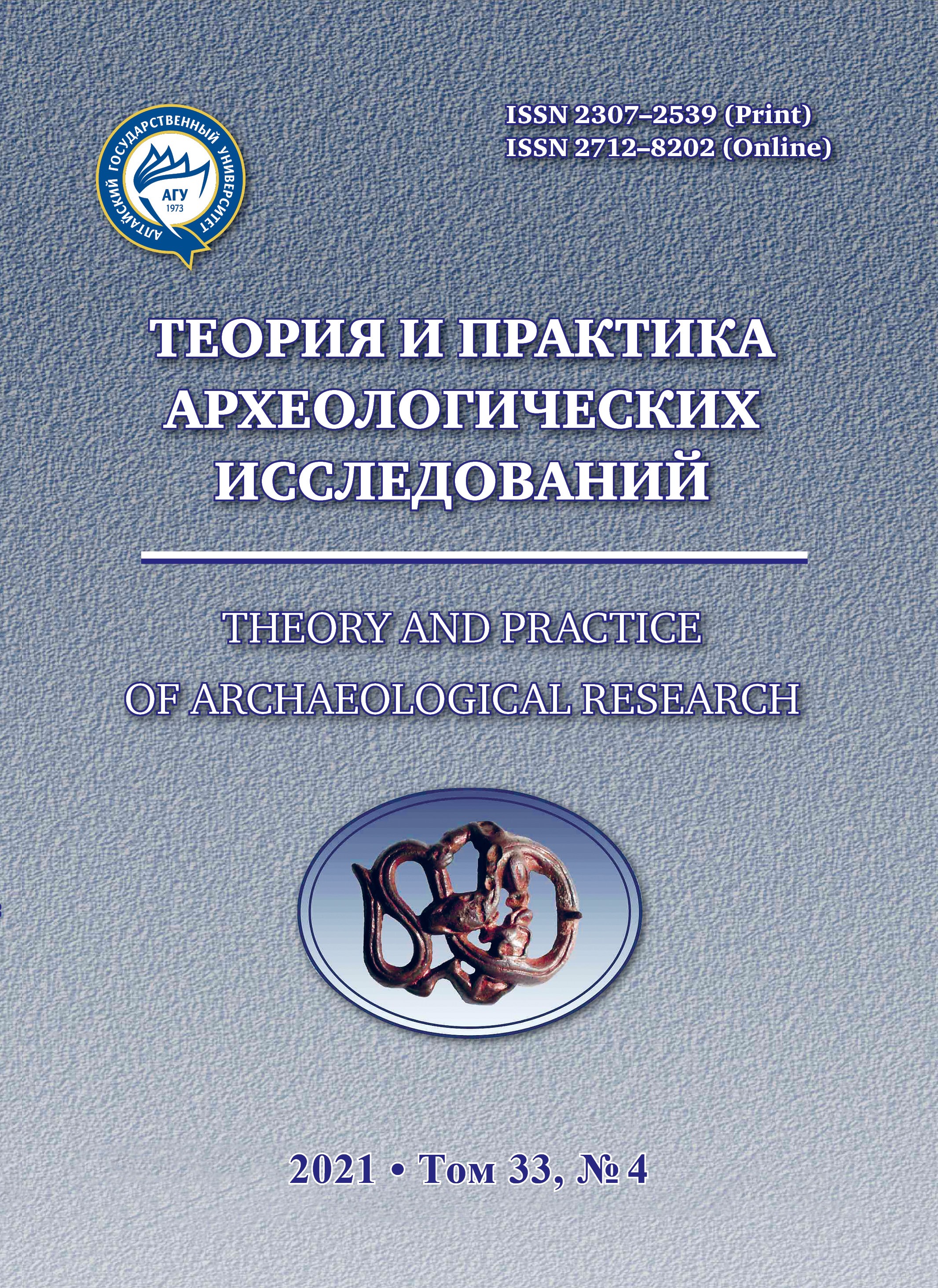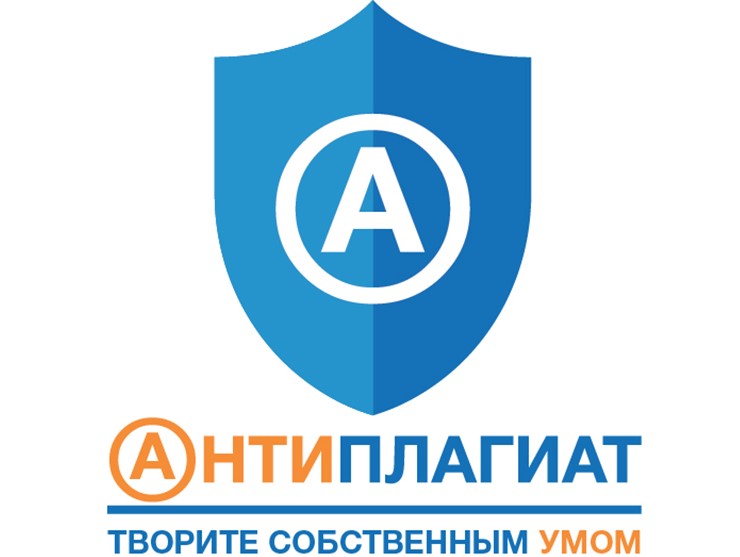Mineral Composition of Ores Used at Ustye-I, a Fortified Settlement of the Bronze Age (Chelyabinsk Region)
Abstract
Abstract. At the fortified settlement of the Bronze Age, Ustye-I (South Trans-Urals), metal products of copper, arsenic and tin bronzes, numerous fragments of metallurgical slags, as well as fragments of copper ores have been discovered. According to the results of early studies, pure copper predominates among metal items (53.4% of finds), but also a significant part contains an admixture of arsenic (25.4% of finds), tin (13.6% of finds) and both components simultaneously (7.6% of finds). Several alloying components of the samples are simultaneously found in slags: Pb (50% of cases), As (49% of cases), Zn (40% of cases), Bi (38% of cases), Sn (7% of cases), Ni (4% of cases), Sb (1% of cases). To identify the relationship between the incoming raw materials and the received metal, 15 ore samples were examined. The ores studied are ‘gravelly’ clasts with a size of 5 mm to several centimeters, and ‘sandy’ ores with a size of 2–3 mm. According to their mineral composition, ores are subdivided into malachite, azurite, and limonite. The main copper minerals are malachite and azurite; chrysocolla is found occasionally, chalcopyrite, cuprite are rarely found. Copper is bound to Fe- and Mn-hydroxides. We have identified copper slag fragments in ‘sandy’ ores. In all types of ores, natural alloying components are very rare and are represented by Pb and Zn. These elements can form their own minerals (mottramit, a mineral of the plumbogummite family) or act as an impurity to malachite (up to 0.62 wt% ZnO), azurite (up to 1.12 ZnO and up to 2.37 PbO), iron hydroxides (up to 2.66 ZnO and up to 2.02 PbO) or manganese hydroxides (up to 0.41 ZnO and up to 9.48 PbO). No As and Sn impurities were found. The presence of numerous fragments of brown iron ore at the settlement, the close location of copper mines indicates that the settlers were engaged in the extraction and processing of copper ore. The widespread occurrence of ores, consisting mainly of malachite and azurite, indicates that the ores were mined from the upper parts of the oxidation zone, and the metal smelted from these ores must correspond to pure copper. The distribution of Pb and Zn impurities indicates that some of the copper ores originate from the oxidation zones of pyrite ores or deposits of other formational types with a similar ore composition. The difference in the compositions of the ores found at the settlement and the compositions of slag and metal is associated with several sources of ores. The sources of copper ores could be mines located near the settlement. Arsenic-bearing ores could have come from mines in adjacent areas. Tin ores were brought in as a result of trans-regional exchange with the Central Asian region.
Downloads
Metrics
References
Agrikola G. About Mining and Metallurgy in Twelve Books (chapters). Moskow : Nedra, 1986. 294 p. (In Russ.)
Belogub E.V. Supergenesis of Sulfide Deposits in the South Urals: Thesis for the Doctor’s Degree. Miass, 537 p. (In Russ.)
Blinov I.A. Chemical and Mineral Composition of Sulfide Nodules from Cuprous Sandstones of Mikhailovsky and Belousovsky Ancient Mines (Orenburg Urals). Mineralogiya = Mineralogy. 2020;6(4):35–45. (In Russ.)
Blinov I.A., Ankushev M.N., Vinogradov N.B., Yuminov A.M. Geochemical Features of Metallurgical Slags and Ores of the Fortified Settlement of the Bronze Age Ustye (Southern Trans-Urals). Geoarheologiya i arheologicheskaya mineralogiya = Geoarchaeology and Archaeological Mineralogy-2015. Miass : Institut Mineralogii UrO RAN, 2015. Pp. 128–136. (In Russ.)
Vinogradov N.B., Degtyareva A.D., Kuzminyh S.V. Metallurgy and Working in the Life of the Inhabitants of the Fortified Settlement Ustye-1. Vestnik arheologii, antropologii i etnografii = Bulletin of Archaeology, Anthropology and Ethnography. 2013;3(22):4–30. (In Russ.)
German-Rusakova L.D. Migration of Elements in the Oxidation Zone of the Blyavinsky Copper-Pyrite Deposit in the Southern Urals. Trudy Instituta geologii rudnyh mestorozhdenij, petrografii, mineralogii i geohimii = Proceedings of the Institute of Geology of Ore Deposits, Petrography, Mineralogy and Geochemistry. 1961: 68. M. : Izd-vo AN SSSR, 1962. 130 p. (In Russ.).
Grigoriev S.A. Metallurgical Production in Northern Eurasia during the Bronze Age. Chelyabinsk: Cicero, 2013. 660 p. (In Russ.)
Degtyareva A.D. Ancient Metal-Production of the Southern Trans-Urals. Novosibirsk: Nauka, 2010. 162 p. (In Russ.)
Degtyareva A.D., Kuzminyh S.V., Orlovskaya L.B. Metal Production of Petrovka’s Culture Tribes (by the materials of the settlement Kulevchi-3). Vestnik arheologii, antropologii i etnografii = Bulletin of Archaeology, Anthropology and Ethnography. 2001;3:4–30. (In Russ.)
The Ancient Ust’ye: a Fortified Settlement of the Bronze Age in the Southern Trans-Urals: Collective Monogr. / ed. N.B. Vinogradov; scientific ed. A.V. Epimahov. Chelyabinsk : Abris, 2013. 482 p. (In Russ.)
Popov V.A., Kobyashev Yu.S. Finds of Astrophyllite, Brokkite, Mottramite in the Ilmensky Mountains. Ural mineralogical collection. Miass : IMin UrO RAN, 1995. №5. Pp. 124–126. (In Russ.)
Popov V.A., Kolisnichenko S.V. To mineralogy of carbonatites of Russian Brazil in the Southern Urals. Ural’skij mineralogicheskij sbornik = Ural mineralogical collection. Miass: IMin UrO RAN, 2008. №15. P. 75–84. (In Russ.)
Rodionov S.M. Metallogeny of Yin in the East of Russia. M. : Nauka, 2005. 327 p. (In Russ.)
Smirnov S.S. Zone of Oxidation of Sulfide Deposits. M.; L. : Izd-vo AN SSSR, 1955. 332 p. (In Russ.)
Yuminov A.M., Noskevich V.V. Geological and Mineralogical and Geophysical Studies of the Ancient Copper Mine Novonikolaevsky (South Ural). Geoarheologiya i arheologicheskaya mineralogiya-2014 = Geoarchaeology and Archaeological Mineralogy - 2014. Miass : IMin UrO RAN, 2014. P. 108–114. (In Russ.)
Thornber M.R. Supergene Alteration of Sulphides VII Distribution of Element during the Gossan-Forming Process. Chemical Geology. 1985;53:279–301.
Theory and Practice of Archaeological Research is a golden publisher, as we allow self-archiving, but most importantly we are fully transparent about your rights.
Authors may present and discuss their findings ahead of publication: at biological or scientific conferences, on preprint servers, in public databases, and in blogs, wikis, tweets, and other informal communication channels.
Theory and Practice of Archaeological Research allows authors to deposit manuscripts (currently under review or those for intended submission to ABS) in non-commercial, pre-print servers such as ArXiv.
Authors who publish with this journal agree to the following terms:
- Authors retain copyright and grant the journal right of first publication with the work simultaneously licensed under a Creative Commons Attribution License (CC BY 4.0) that allows others to share the work with an acknowledgement of the work's authorship and initial publication in this journal.
- Authors are able to enter into separate, additional contractual arrangements for the non-exclusive distribution of the journal's published version of the work (e.g., post it to an institutional repository or publish it in a book), with an acknowledgement of its initial publication in this journal.
- Authors are permitted and encouraged to post their work online (e.g., in institutional repositories or on their website) prior to and during the submission process, as it can lead to productive exchanges, as well as earlier and greater citation of published work (See The Effect of Open Access).








2.jpg)



